Sharing ICH knowledge in the Nordic and Baltic region
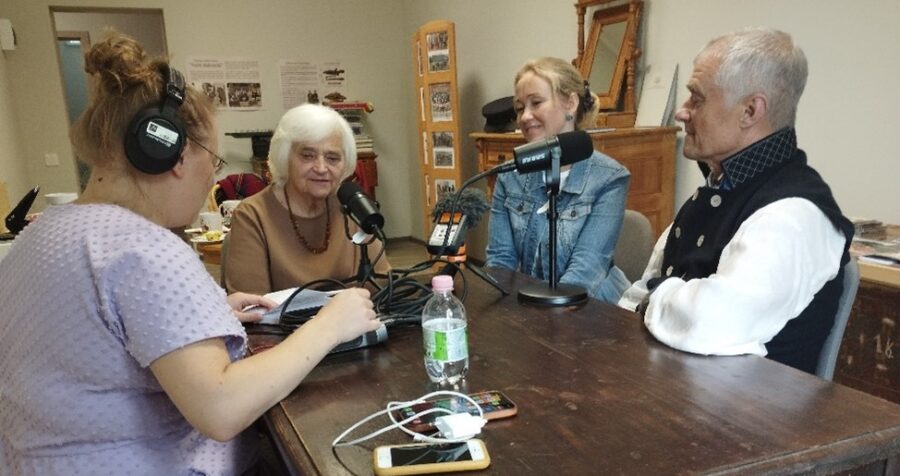
Background
Main photo: Interviewing in Suiti. Photo: Solveig Grinder.
Sharing is good practice. Sharing experiences in safeguarding intangible, living, cultural heritage, is a key aim of the Safeguarding Practices webpage.
The Nordic and Baltic network on Intangible Cultural Heritage has initiated both seminars and exchange visits in the Nordic and Baltic region.
The exchange visits described in this article were carried out through two projects, coordinated by the Finnish Folk Music Institute. Some of the exchanges were part of the Erasmus+ funded project Sheritage, which aimed to increase knowledge and understanding of ICH and to build capacities to work with ICH through networking, co-operation and exchange. The second part of the exchanges was funded by the Nordic Culture Point. The aim of the project Nordic-Baltic ICH/Research was to raise awareness of good safeguarding practices among those working in research.
Participants shared their experiences during their visits, and through blogs, reports and /or video reports after the visits.
How it was done
From Sagobygden to Lillehammer
Tine Winther from Sagobygden, Sweden, visited Norwegian Crafts Institute at the outdoor museum of Maihaugen, and Bjerkebæk, the home of Nobel laureate Sigrid Undset (1882-1949) , all part of Lillehammer Museum.
Tine tells about the background:
After several interesting conversations with Einar Stamnes at the Norwegian Crafts Institute, I got the privilege of visiting Maihaugen, an open-air museum located in Lillehammer, Norway in May of 2023. …Einar and I have had conversations about the intangible cultural heritage we represent, Einar crafts and I oral storytelling. We have given each other book recommendations, talked about places to visit and people who have been important to the work with living traditions.
Every year in May, Lillehammer hosts the Norwegian Festival of Literature. Norwegian Crafts Institute, Lillehammer Museum and The Norwegian Network on Living Heritage cooperated with the festival with a program on oral storytelling. Tines visit would involve meetings and discussions about oral tradition.
Storytelling and UNESCO have a close connection. UNESCO recognizes the importance of storytelling as a form of cultural expression and as a means of preserving and transmitting cultural heritage. By promoting storytelling and oral tradition, UNESCO contributes to preserving and protecting cultural diversity and intangible cultural heritage around the world.
Eivind Falk from Norwegian Crafts institute told about the work with the publication Heritage Alive and the last theme: storytelling, where Tine also contributed with an article on Sagobygden – Land of Legends.
Tine Winther tells more from her visit:
In order to gain an understanding of the structure of a story and to show that everyone can tell a story, we were privileged to have a mini-workshop with Johan Einar Bjerkem, who on a daily basis is the leader of the Hilmar foundation in Steinkjer. When Johan Einar got us started with exercises, we soon realized that we had a lot to tell each other and that it was difficult to keep us quiet, before it was time for the next lecturer.
Everyone have a story to tell, Bjørn Enes highlighted during his lecture, Bjørn represented the association Memoar which was formed in 2015. He told about the big collecting of memories and life stories there has been going on since mid-19th century in Norway. Memoar as an organization collect modern oral history. They collect, preserve and disseminate oral history interviews in video format. There slogan – «Everybody has a story to share» – reflects on a collective responsibility for transferring the story of our times to future generations.
The recorded interviews remain the intellectual property of the interviewee (and the interviewer). They encourage people to share their stories in public archives and in social media. The solid collection of around 500 personal stories can largely be found on the websites www.memoar.no and minner.no. An important part of the work involves teaching others how to conduct interviews, and lowering the threshold for interviews and for telling stories.
Legends and stories for the future
Our own personal stories are important, so is legends. Legends are short stories; they are told as truths and are often location-bound. They tell us something about the time they were first told in, the place, faith, superstition and life, writes Winther in her report.
One who uses legends in his stories is Lars Mytting, Norwegian novelist and journalist from Fåvang in the Gudbrandsdalen valley. Lars Mytting’s stories are based on the legend around which he spins his story, fantastic moving stories that Lars told about in a panel discussion together with the head of culture at Lillehammer municipality (Unesco City of Literature) Olav Brostrup Müller, and the leader of the Sigrid Unset Society and curator at Bjerkebæk and Aulestad at Lillehammer Museum: Kristin Brandtsegg Johansen. The moderator was Einar Stamnes.
The stories live with us all the time and when we tell them together it’s like breathing together. Filled with new impressions after the visit to Lillehammer, I traveled home to make the final preparations for Sagobygden music and storytelling festival, which is the oldest recurring storytelling festival in the Nordics, tells Winther.
From Suiti to Kaustinen
Māra Rozentāle and Juris Lipsnis, from the Suiti Cultural Heritage Foundation (Latvia) visited Kaustinen and the Finnish Folk Music Institute on the 12th to 16th of July 2023.
During the visit they participated in the Kaustinen Folk Music Festival. The festival has been held every July since 1968 and is the biggest folk music and dance festival in the Nordic countries. Both visitors are also members of Latvian folk-group Suitu dūdenieki (Suiti Bagpipers)
The Kaustinen Intangible Cultural Heritage Seminar 2023 Building peace with intangible cultural heritage was a part of the festival’s peace theme of the year.
Juris Lipsnis comments: Experts and artists from different parts of the world dealt with the role and position of intangible cultural heritage in situations of armed conflicts from a multi-perspective: how can one prepare for safeguarding heritage, what can be done in the middle of a conflict and what significance can intangible cultural heritage have in recovering from conflicts.
Safeguarding living heritage- through involvement and adaptation.
Mara Rozenthale comments from the visit:
I consider the visit as really useful, I got a lot of valuable information, ideas, I got acquainted with the activities of the host organization and good practices – theoretically and practically (by participating in the Kaustinen Folk Music Festival). The involvement of the local community in the preservation and promotion of living traditions should be noted as a special good practice that I observed during the visit. I also gained many new contacts and potential cooperation partners from Finland and other countries. Also, this was a good opportunity to popularize Suiti culture and our NGO on a wider scale.
The Kaustinen festival is an excellent example of how living traditions – playing instruments and making skills, storytelling and other types of intangible cultural heritage – are safeguarded. The festival’s inclusive approach gave food for thought on the importance of not freezing intangible cultural heritage, but allowing it to adapt to people’s lifestyles and global trends, while preserving its foundation – as defined in the The Convention for the Safeguarding of the Intangible Cultural Heritage.
From Tallinn to Kaustinen
Textile historian Sophie Qiaoyun Peng (University of Glasgow) travelled from Tallinn to Kaustinen (via Helsinki & Jyväskylä) in August 2023 to visit the Folk Arts Centre.
Safeguarding through widening access
During this visit, Sophie discovered that the key to safeguarding living tradition is widening access, which Kaustinen can be seen as a model. She is in particular impressed about the idea that music should be designed for everyone in Kaustinen, as this is what she missed out during her childhood due to lack of access and the elitism in music education. She observed the local community activities by attending orchestra rehearsal, and is also very impressed by the high level of local amateur musicians. Sophie also spotted violin-related symbols in the Kaustinen cultural landscape which reflects the importance of folk music in the region.
From Kaustinen to Sagobygden
Anni Järvelä, Education manager at Finnish Folk Music Institute, visited Sagobygden in august 2023.
Sagobygden – The Land of Legends – located in Ljungby, Alvesta and Älmhult in Sweden, is managed by The Storytelling Network of Kronoberg, whose storytelling activities are listed in UNESCO’s Register of Good Safeguarding Practices. Read also an article about Sagobygden on safeguardinpractices.com here.
Keeping storytelling alive
The network aims to spread knowledge of folktales and legends emphasizing people’s own stories in today’s society. They also act as a network between people who are interested in storytelling. The center of the activities lies in Sagomuseet, The Museum of Legends, in Ljungby. The museum hosts numerous captivating workshops and tours for schools and to the public on a yearly basis.
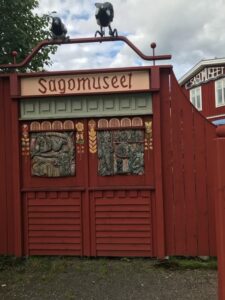
Welcome to Sagomuseet! Photo: Anni Järvelâ.
Järvelä comments:
The Network also organizes a Storytelling festival every June in Ljungby with around 50 storytellers sharing their most interesting and fun stories. I hope I´m able to visit the festival sometime in the future! In addition, the network organizes educational activities for all ages from small children to university studies and works together with the Institute for Language and Folklore in implementing the UNESCO Convention of Safeguarding the Intangible Cultural Heritage.
It was a true pleasure to get the chance to follow the dedicated work of the network. It´s various forms of spreading knowledge through interactive methods are an inspiring example for everyone working with safeguarding ICH!
From Oslo to Suiti
Solveig Torgersen Grinder, Senior adviser at the Norwegian Folk art and Craft Association, visited Suiti, Latvia during 26.– 27. August 2023. She visited Suiti Cultural Heritage Foundation and Suiti Crafts Day in Alsunga.
Grinder tells about her introduction:
With excellent travel instructions given me from Māra Rozentāle from Suiti Cultural Heritage Society I arrived by bus in the city of Kuldiga. Accommodation in the historical part of the city was booked and the first evening I was introduced to Juris Lipsnis and Māra Rozentāle , members of the board of the Suiti Cultural Heritage of the Alsunga society. There was also another exchange visitor present, Amanda Kauranne from Finland. Her task was to record interviews with Suiti people to make podcasts that are planned in the Exchange project. In the first part of the day Māra Rozentāle took the two of us for an interesting walk in the historical center of Kuldiga.
Kuldiga Old Town has now, since the visit, been inscribed to the Unesco World Heritage list.
After this introduction they traveled to Jurkalne in the Suiti region. This area, very close to the Baltic Sea had over 1000 inhabitants, and today there are only about 300 left. There is no longer any school in the municipality. The area faces serious challenge for maintaining and transmitting the local traditional knowledge. The younger generations tend to leave for study and work.
They were welcomed by Ligita Kalniņa working for the municipality in the Jūrkalne Library. She is also in charge of the the weaving workshop at first floor. She is also a weaver herself.
Food recipes, traditional music and instruments, dressmaking, song and language. Al these expressions were at high risk to disappear. This was the background for applying for inscription at the Unesco Urgent Safeguarding list. After inscribing the Suiti Culturale Space at Unesco Urgent Safeguarding list in 2009, several safeguarding measures has been taken e.g production of the film “Preserving Centuries”
The next stop was at the Culture Center in Alsunga were they got a presentation of the work of the Suiti Cultural Heritage of the Alsunga (SCH) society by the host Māra Rozentāle. SCH is located in Alsunga Craftshouse. Suiti Cultural Heritage (SCH) was founded in 2013 with the object to “preserve, protect and develop” Suiti cultural traditions. SCH have taken part in several international Erasmus+ projects. This has been a way to implement Suiti cultural Space safeguarding plans and to raise awareness in the local communities. The safeguarding plan has been made with assistance from experts. The plan has a 5-year duration and are regularly updated.
Safeguarding activities which have been initiated:
- CD production about Suiti region history and traditions
- Collected and written down 50.000 folksongs.
- Collected stories from Suiti tradition bearers.
- Several books and booklets describing and documenting traditions
- Annual activity books for children, given to libraries and sold to municipalities.
- Research on Suiti language a dictionary published online.
- Seminar and workshops for traditional music, local and international
- Annual bagpipe festival since 2018
- Seminar and workshops for traditional craft skills
- Annual Suiti Craft Day
- Youth project: Suiti historical pilgrimage by bicycle
- Collaboration with local folks’ groups “Suitu sievas”, “Suitu vīri” on workshops concerts and performances with local, national and international participation
Grinder continues:
In the afternoon Amanda made her recordings of interviews with two local Suiti people – experts in preserving Suiti cultural heritage. Listening to this was highly relevant also for me and I am glad I got the opportunity to be present. During the interviews the essential question was raised: How to safeguard? Here are a few answers:
- You have to have the will to do it.
- You have to know what to safeguard.
- You have to have a will to pass knowledge on to the next generation.
- You have to have a list of values.
- You have to organize and put actions in some order.
- You have to make an inventory.
- You have to define what is really important for yourself.
- You have to be persistent and brave.
- Everything starts with your heart!
On Sunday 27.th August they participated at the Suiti Craft Day in Alsunga. At the central square besides the Alsunga Culture Centre there is a marked every Sunday where local producers show and sell their products. About 30 producers of traditional food, vegetables, different crafts have stands. Once a year it is organized the Suiti Craft Day with numerous workshops for free, for both children and adults. This is an initiative for raising awareness of, and interest in local traditions within first of all crafts, but also music and food.
By the end of the day I was given possibility to have my presentation for the audience inside at the Alsunga Culture Center. The title of my presentation was: Safeguarding Handicraft Traditions Through Dialogue and Participatory Democracy. Māra Rozentāle interpreted from English to Latvian and after my presentation there were many questions connected to my topic and to the Norwegian nomination file sent this winter(2023) to Unesco for inscription on the Representative list of ICH. The title of the nomination is: Traditional costumes in Norway, traditional handicraft and social practice.
It is of the greatest importance to have possibilities to meet colleges in person. The value of inspiring and prepared meetings cannot be underlined enough. Watching, listening, and participating in safeguarding activities in a new and unfamiliar context functioned for me as a tool of analyzing what we are dealing with in our own ICH safeguarding work, and in this way giving me new knowledge and inspiration to our further work. The way the visit was organized, with both observing and participating myself, and having the possibility to share own experiences was very fruitful, Grinder concludes.
From Soomaa to Helsinki
As part of the Nordic and Baltic Network on ICH exchange activities, 10. – 13. of December 2023, boat builder Aivar Ruukel from Soomaa (Estonia) visited boat researcher Harri Luukkanen in Helsinki, Finland. Harri has researched early boats and canoes of Finland (since 1985) and Northern Eurasia and he is the author of the book The Bark Canoes and Skin Boats of Northern Eurasia.
Aivar is an experienced builder of expanded dugout canoes (since 1996), but a beginner in boat related research. He is planning to write and publish in 2024 an article about Estonian expanded dugout boat culture.The exchange visit provided an insight into the academic world of boat research and work of Harri Lukkanen. Luukkanen was sharing his experiences , both good practices and obstacles, in research methods, as well as writing and publishing. The program included a day in the literature archive in his summerhouse in Sipoo. Working in archives and discussions provided ideas about capacity building to better safeguard the living heritage of building and use of expanded dugout boats in the Soomaa region. Also visiting Sipoo Canoe Club was inspirational, where Luukkanen has been a kayaker since 1958 and a canoe sailor since 1986 and build several canoes for paddling and sailing.
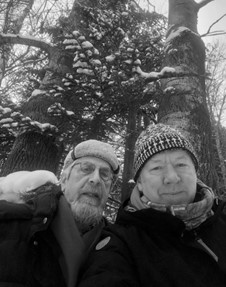
Photo: Aivar Ruukel.
From Sagobygden to Kaustinen
Tine Winther ,Director (Verksamhetsledare) at Sagobygden, Sweden, tells about her exchange visit to Kaustinen, Finland:
In the middle of the November darkness, I got the opportunity to come to a snow white Kaustinen, where I participated in the eleventh national Children’s Culture Forum. The theme for this year was living cultural heritage, a theme that really suits Sagobygden with our strong storytelling tradition. Participants from all over Finland came with an open mind, a curiosity, and a joy for the substantial program. All the speakers talked about living cultural heritage with great enthusiasm. There are many angles to what a living cultural heritage is and that is what makes it so exciting. I had the opportunity to present Sagobygden’s broad activities and together with everyone in the audience we did a story game with sign language as support.
A living cultural heritage touches, it adds a golden edge to existence. We want to be touched and I certainly was by listening to the speakers and listening to the large orchestra with musicians and singers of all ages, that are one of the cores in The Finnish Folk Music Institute. Through workshops we got to immerse ourselves in some cultural heritage, I got to hear Sami stories in song, play marimba, make ornaments from recycled materials and dance folk dance.
The days gave me new contacts, with new angles. I got to hear wise thoughts and got ideas for developing our own work. Meetings are so incredibly important for us to grow as people together.
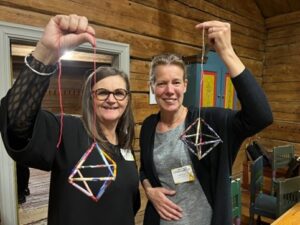
Photo: Tine Winther
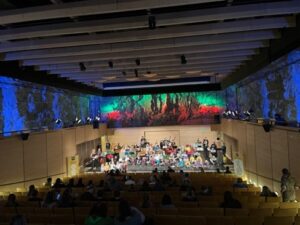
Photo: Tine Winther.
Finland and Sagobygden- Sharing storytelling experiences
Storyteller Anna-Maria Toivoinen, storyteller and teacher met and shared experiences online in the fall of 2023 with representatives from Sagobygden.
Toivonen tells about the exchange:
Unfortunately, due to my teaching obligations I couldn’t travel there to experience the Museum of legends in person, so I had to settle to online exchange. Thanks to wonderful Tine Winther the director of Sagobygden and Jacob (one of the full-time storytellers at the Sagobygden) I was able to get a little clue what is going on there. And it really is a lot going on there!
The Storytelling Network of Kronoberg is a nonprofit organization that cares about the oral tradition. They want to contribute to oral storytelling tradition being carried on and they want to spread knowledge of legends and folktales. They are located in Ljungby where they run The Museum of Legends. They organize performances, lectures, university courses and festivals. They have three full-time storytellers who arrange both public and private storytelling performances for schools, nursing homes, associations, and companies.
Just to open up a little bit of the background of the meaning of this place you need to know that in 2018 the Land of Legends Sweden was adopted on to UNESCO’s Register of Good Safeguarding Practices. And being on this register means that you have an exceptional good methodology on how to work with intangible cultural heritage.
So what did I learn from this visit? I learned that they have had a long journey to get where they are now. And the journey never ends as they need to fight for the money year after year to keep up the good and important work they are doing. They must ensure that it is essential to treat professionals like they should be treated – meaning for example that they need to be paid of the work they are doing.
Toivonen reflect on the situation in Finland and whether a storytelling network could be a way to go:
This co-operation made me think about the situation here in Finland. We have no roof organization for professional storytellers. Should we have and what would it take to build up one? We are at least few professionals working on this field. We all have found our ways of making living and we are working more or less full-time – not just performing but running workshops, teaching, applying grands and so on… so what would it mean if we all worked under the same roof? Not an easy question but at least it would be good to gather up and hear about each other´s work and projects regularly and give support for each other. Sometimes I feel a bit lonely working so hard but not being able to have counseling and tutoring from other´s working on the same field in Finland.
I made a list of all kinds of safeguarding practices I know is done in Finland (and I really don´t know everything that is done!) and I can say from the bottom of my heart that we are doing a lot also what it comes to storytelling. But what we lack here is the long-term education for storytelling.



